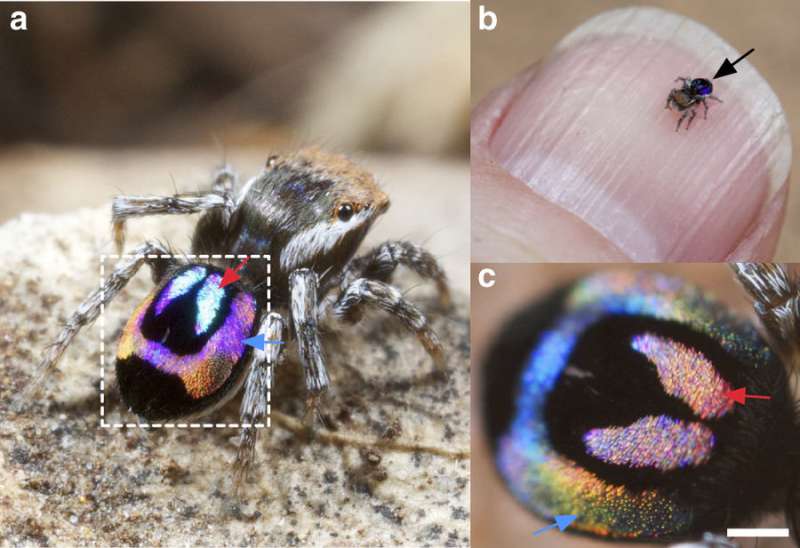Rainbow peacock spiders may inspire new optical technologies

Even if you are arachnophobic, you probably have seen pictures or videos of Australian peacock spiders (Maratus spp.). These tiny spiders are only 1-5 mm long but are famous for their flamboyant courtship displays featuring diverse and intricate body colorations, patterns, and movements.
The spiders extremely large anterior median eyes have excellent color vision and combine with their bright colors to make peacock spiders cute enough to cure most people of their arachnophobia. But these displays aren't just pretty to look at, they also inspire new ways for humans to produce color in technology.
One species of peacock spider – the rainbow peacock spider (Maratus robinsoni) is particularly neat, because it showcases an intense rainbow iridescent signal in males' courtship displays to the females. This is the first known instance in nature of males using an entire rainbow of colors to entice females. Dr. Bor-Kai Hsiung led an international team of researchers from the US (UAkron, Cal Tech, UC San Diego, UNL), Belgium (Ghent University), Netherlands (UGroningen), and Australia to discover how rainbow peacock spiders produce this unique multi-color iridescent signal.
Using a diverse array of research techniques, including light and electron microscopy, hyperspectral imaging, imaging scatterometry, nano 3D printing and optical modeling, the team found the origin of this intense rainbow iridescence emerged from specialized abdominal scales of the spiders. These scales have an airfoil-like microscopic 3D contour with nanoscale diffraction grating structures on the surface.
The interaction between the surface nano-diffraction grating and the microscopic curvature of the scales enables separation and isolation of light into its component wavelengths at finer angles and smaller distances than are possible with current manmade engineering technologies.
Inspiration from these super iridescent scales can be used to overcome current limitations in spectral manipulation, and to further reduce the size of optical spectrometers for applications where fine-scale spectral resolution is required in a very small package, notably instruments on space missions, or wearable chemical detection systems. And it could have a wide array of implications to fields ranging from life sciences and biotechnologies to material sciences and engineering.
More information: Bor-Kai Hsiung et al. Rainbow peacock spiders inspire miniature super-iridescent optics, Nature Communications (2017). DOI: 10.1038/s41467-017-02451-x
Journal information: Nature Communications
Provided by Ghent University





















